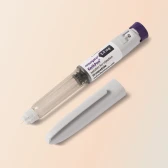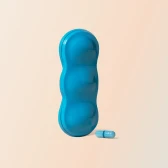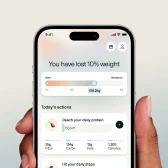Oestradiol is a type of oestrogen—often called a “female hormone”—but men make it too. And it plays a big role in male health. In men, oestradiol helps keep your bones strong, mood steady, sex drive healthy and heart working properly.
When your levels are off, it can affect everything from your sleep and energy to your body shape and sex life.
Here’s what oestradiol does, what healthy levels look like, and how to check yours with a simple blood test.
What is oestradiol?
Oestradiol (E2) is one of three main oestrogens in the body. The others are oestrone (E1) and oestriol (E3). Oestradiol is the most active and biologically potent form of oestrogen. Like other steroid hormones, it’s made from cholesterol.
Men don’t produce oestrogen directly. Instead, they convert some testosterone into oestradiol through a process called aromatisation, which mainly occurs in the liver, body fat, muscle, and testes.
On average, men have about one-tenth the oestradiol of pre-menopausal women, but it’s still essential for their wellbeing.
Is oestradiol the same as oestrogen?
Not exactly. “Oestrogen” refers to the whole family of related hormones (E1, E2, E3). “Oestradiol” (E2) is the most potent type—and it’s the one most blood tests measure.
What does oestradiol do for men?
Even in small amounts, oestradiol supports wellbeing in men such as:
- Bone health: Maintains your bone strength
- Brain and mood: Supports your memory, focus and emotional stability.
- Sexual function: Regulates sex drive, erections and sperm production.
- Heart and circulation: Helps regulate blood pressure and arterial flexibility.
- Fat distribution: Influences where fat is stored. Low oestradiol is linked to more belly fat, even when testosterone is normal.
Oestradiol works alongside testosterone. Too much can blunt testosterone’s effects; too little can cause bone loss, low libido, and fatigue. The goal isn’t to eliminate oestradiol—it’s to keep it in balance.
Normal oestrogen levels in men
Typical oestradiol levels in healthy adult men range from 30–40 pg/mL (or 110–150 pmol/L). Exact ranges vary between laboratories because testing methods differ slightly, so always compare your result with the reference range on your own report.
Average estradiol (E2) levels in men by age
*Conversion used: 1 pg/mL = 3.671 pmol/L.
For comparison, women’s oestradiol fluctuates between 30-400 pg/mL (110-1468 pmol/L) during their menstrual cycle.
Low vs high oestradiol in men
Both too much and too little oestrogen can cause problems for men.
Low oestradiol
Low E2 often goes hand-in-hand with low testosterone.
Common causes: low testosterone; can also follow severe dieting, over-training, eating disorders, chronic illness, or very low body fat.
Typical signs: low libido or weaker erections, low mood, low energy, poor sleep, bone or joint aches and more belly fat.
Why it matters: Low oestradiol raises your long-term risk of osteoporosis and can impact fertility.
High oestradiol
When men produce too much oestradiol, it’s known as hyperestrogenism.
Common causes: higher body fat, frequent alcohol use, liver disease, insulin resistance or type 2 diabetes, hyperthyroidism (overactive thyroid), and high-dose TRT or anabolic steroids.
Typical signs: breast tenderness or gynaecomastia (breast tissue growth), reduced sex drive and erection quality, irritability, fatigue, and fat gain around the hips and thighs.
Why it matters: High oestradiol is often linked with obesity, liver disease and insulin resistance—all of which increase heart and metabolic risk. It can also suppress testosterone production over time.
High or low oestrogen in men: Which is worse?
Both are problematic. Too little harms bones and fertility; too much blunts testosterone’s benefits.
The key is balance—not driving oestradiol too high or too low.
How to check and manage your oestrogen levels
Testing your oestradiol
A serum oestradiol blood test measures how much active oestrogen is in your system. It’s often done alongside a testosterone test, since the two hormones are closely linked.
You should consider testing if you notice:
- Low energy or mood changes
- Reduced libido or erection quality
- Unexplained fat gain or muscle loss
- Symptoms of low testosterone or TRT side effects
At Voy, you can order an enhanced blood test that checks both oestradiol and testosterone. Results are fast and clinician-reviewed, with clear guidance on what they mean for you — no GP wait times, just clarity and next steps.
Managing oestradiol levels
Oestradiol levels naturally fluctuate, so small changes aren’t a concern. If your levels fall outside the normal range and you have symptoms, there are safe, effective ways to restore balance.
When oestradiol is low:
- Treat underlying low testosterone (your doctor might recommend TRT).
- Eat enough calories and protein to support hormone production.
- Prioritise rest, strength training and stress control.
When oestradiol is high:
- Reduce excess body fat through diet and lifestyle changes.
- Limit alcohol and manage insulin resistance.
- In some cases, your clinician may prescribe an aromatase inhibitor, a medicine that blocks the conversion of testosterone into oestradiol.
Because testosterone and oestradiol are interlinked, optimising testosterone usually brings oestradiol back into range.
Get started with TRT today
Testosterone replacement therapy (TRT) is the most effective way to restore low testosterone—and it can also help balance oestradiol. Wondering if low testosterone is holding you back? Take our short quiz to see if TRT could help you feel your best again.












